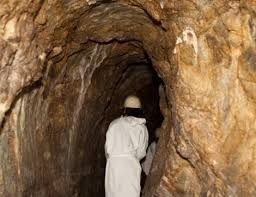Important Aspects of Engineering Geology concerned with Tunnelling:
- Classification of Rock Formation is needed for the design of temporary support-system, then for permanent support-system if considered necessary.
- Effect of Geological Structural Features and Weathering and Erosion especially Chemical Weathering on the strata of the tunnel as well as on the surrounding strata.
- Effect of ground-water as well as trapped water, on the tunneling works
- Sloping of the strata.
- Rock of easily varying nature due to the external (esp. weathering) effects.

-
“Terzaghi’s Classification of Rock Formation” in comparison to the “General Rock-Mass Classification especially for Tunnelling Works”:
- He proposed that it is more important to classify the Rock-Mass on the basis of the work that is to be carried out, rather than on the ordinary basis e.g. on the basis of origin or mode of formation of the rocks, etc.
- Load on the tunnels made in the rocks is quite different from those which are made in the earth. In the rocks, there is the load of the rocks especially the Dead Load, whereas in the earth there is Earth Pressure.
- In the tunneling and tunnels in the earth, too much temporary supports (while tunnel is in the working and advancing stage) are needed and finally more permanent support are needed as compared to the tunneling and tunnels made in the rocks.
Terzaghi’s Classified his Rock Formation in the following Seven Statements:
1) Tunnels in intact and solid rocks
2) Tunnels in unweathered horizontally stratified rocks such as Sedimentary Rocks, and in unweathered vertically stratified i.e. foliated Metamorphic Rocks such as Schist
3) Tunnels in moderately jointed massive rocks
4) Tunnels in crushed rocks
5) Tunnels in blocky or seamy strata
6) Tunnels in decomposed rocks as in organic soils
7) Tunnels in expansive soils derived from the rocks.
Some important information to be kept in view while designing a tunnel:
1) In addition to the above-mentioned Terzaghi’s Classification, the details concerned with the types of rocks e.g. limestone, sandstone, granite, schist, gneiss, etc are also considered.
2) Magnitude of the vertical load acting on the roof, floor and foundation of a tunnel is considered in addition to the horizontal component of earth pressure
3) In the tunnels made in intact and solid rocks with a little earth / soil, the horizontal component will also be very little è zero
4) In the tunnels made in the folded mass of rock, the horizontal component depends upon whether the horizontal pressure which produced that fold is still active
5) Tunnelling works carried out in the sloping bedding, folds, faults, joints, fractures and in the rocks with active chemical changes:
A tunnel to be made in a fault occurring along the central horizontal axis of an anticline or syncline is the most difficult type of the tunnels.
Tunnels made in the highly slanting bedding and in the over-thrust and recumbent faults are also very difficult types of tunnels.
Due to the effect of Rock Creep on the tunnels built on the sloping strata, planning of a tunnel in such a strata must be avoided.



